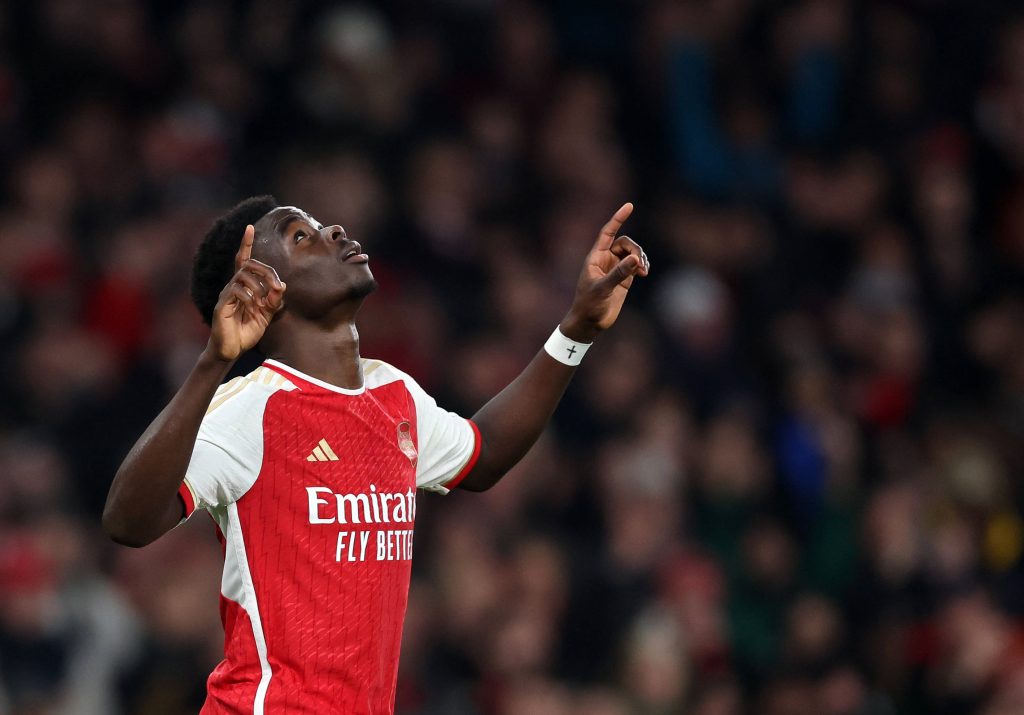In this series, Josh Hobbs explores some of the novel metrics we have been able to develop using the TransferLab algorithm.
One of the perennial problems using data to analyse football is the discrepancy that exists between those with the ability to manipulate data and those who understand what is taking place on a football pitch. Where data scientists will be able to build models or scrutinise the numbers, they may not know how to structure their models or implement their findings on the training ground. Equally, where football coaches will be able to break down the game into phases of play or recognise rehearsed patterns, they may not have the ability to make the data coherent in a way that helps them in their jobs.
At Analytics FC, we have attempted to overcome this problem by building a model which begins to interpret the raw data. Using our unique TransferLab algorithm–a Markov Chain model–we are able to take events that happen on the football pitch and ascribe them a numerical value which indicates how much an action improved that possession’s probability of ending in a goal (and just as importantly, how much it reduced the other team’s chance of scoring on the next possession).
For example, a player receives the ball in central midfield. At this point, the team might have a 1.5% chance of scoring at this point in the possession and also a 1% chance of conceding on the next possession. That situation isn’t very valuable. But if the player executes a dangerous through-ball into the final third, the team is now in a much better position and might have a 6% chance of scoring and only a 0.5% chance of conceding. The pass would be worth the difference in their team’s situation before and after it.
The algorithm calculates every action and can therefore determine the overall impact a player has through all their actions and the impact is presented to clubs in terms of “Goal Difference Added” per 90.
The beauty of this approach is that it allows you to farm the data to find the sorts of actions that are creating value for teams and model your game-style to reflect that. If a certain pass into the box is proving a good source of value for a team, then the coach might want to think about ways to encourage those sorts of actions within the game. Suddenly, data and coaching are much more closely aligned.
In this series, we are going to explore some of these actions that add value to a team’s game:
Switching the Play
One of these actions is switching the play from one flank to the other.
On the face of it, it’s a fairly simple thing to do – any player with decent technique can play a long pass from one wing to the other. However, in a match based scenario it requires excellent technique and awareness of both one’s own teammates as well the positioning of the opposition.
Influential managers such as Marcelo Bielsa and Pep Guardiola have incorporated the switch of play as a key part of their attacking process with the principle of ‘overloading to isolate’. Jed Davies illustrates this principle brilliantly in this short video.
‘Overloading to isolate’ involves a team drawing the opponent over to one flank by building up on that side with the majority of one’s attacking players, then quickly switching the ball to a winger on the other side who has a 1v1 situation with a full back where they can create a chance to score.
This example, taken from Bielsa’s Leeds playing in the Championship last year, is the perfect illustration:
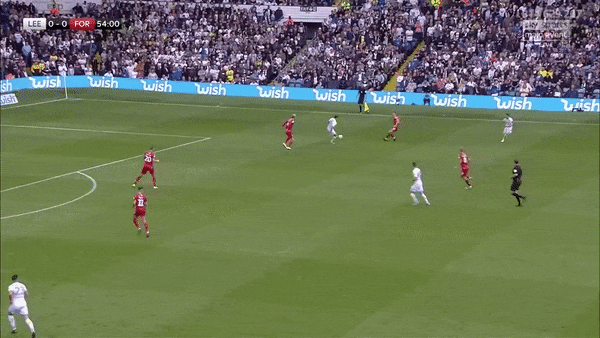
Leeds had five players over on the right-hand-side, as this is the area they tend to overload. Patrick Bamford passed the ball back to Adam Forshaw, who had performed a quick scan of his surroundings as the ball came towards him and immediately switched to Jack Harrison in space on the left. The Forest defence then had to shift across as they had been pulled to the other side by the overload.
This is something that Leeds haven’t done as often in the Premier League as they are less ball-dominant and therefore play much more in transition, but in their two seasons under Bielsa in the Championship, this was one of their key movements in the attacking phase. Harrison would look to cross from this position or a full back would overlap him and go to the byline for a cutback.
For those interested, this piece reviewing Leeds’ title winning season contains much more detail on how this played out on the pitch.
Finding the best players at switching play using TransferLab
Thanks to TransferLab’s algorithm, it is now possible to find players who add the most value to their team’s goal difference through their ability to block crosses. In TransferLab, we now have access to a new metric: ‘Switching play (quality)’.
The definition of ‘switching play’ in this case is as follows: ‘a pass that travels at least half the width of the pitch where the previous pass has been received from one wide channel and the pass is directed to the opposite wide channel.’ This is what we saw in the example above: although Forshaw is in a more central position, the pass he received from Bamford came from the right with Forshaw switching to the left.
Sorting by this metric and filtering for players who have a minimum of 720 minutes in TransferLab’s top three tiers of competition, here are the top performers for the 20/21 season:

Immediately, this metric passes the eye-test for me as I would expect to see Harry Kane on this list. He has often dropped into a deeper position looking to find Son on the left flank.
Also, Trent Alexander-Arnold is perhaps one of the most famous utilisers of the switch of play in football at the moment. Liverpool’s title winning season in 19/20 was built upon Alexander-Arnold playing as a playmaker from a full back position, switching to his opposite full back Andy Robertson or to Sadio Mane on the left wing.
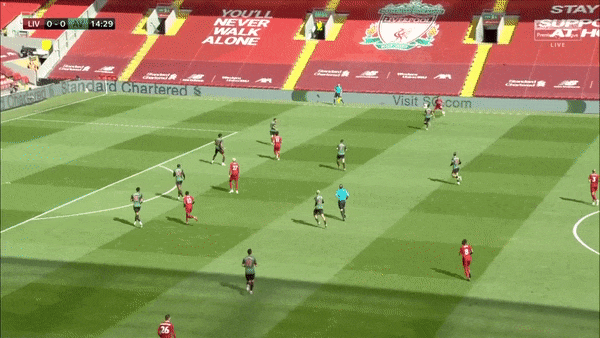
In this example, observe how Aston Villa’s entire team are drawn to the right, leaving huge space for Alexander-Arnold to hit. Contrasting with the previous example, where Forshaw had received the ball almost sideways on, Alexander-Arnold was moving forwards on receiving the ball, facing the play. He took a touch and glanced up before making the pass. The pass itself may have been slightly over-hit but Robertson was still able to get the ball into a dangerous area.
Reading’s teenage star, Michael Olise, also featured in the top performers for this metric. It’s worth having a look at his TransferLab profile in an attacking midfield (playmaker) template:
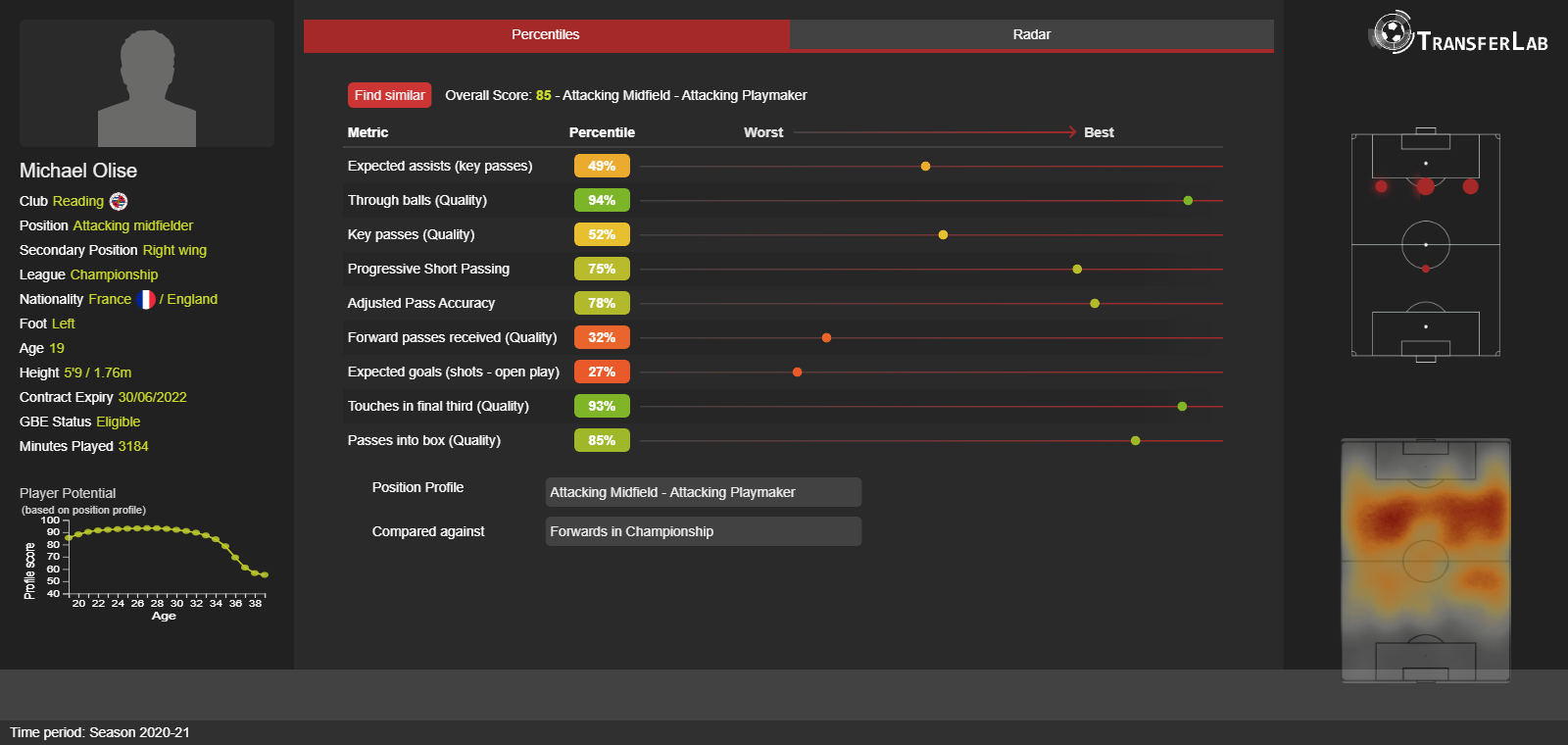
He is a player likely to be on the move this summer, after a tremendous breakout season in the Championship, with multiple clubs at the top level taking an interest.
As you can see from his heatmap, he operates all over the midfield third. He’s always on the move to find space and play the ball forwards. He ranks in the 94th percentile in the Championship for through balls, often looking to put Lucas Joao in on goal. However, as we can tell from his high performance in the switches of play metric, he also looks to spread the ball out wide, often drifting to the right and playing the ball over to Ovie Ejaria on the opposite side.

Here is a player with supreme confidence in his own technique. Again, note the glance over his shoulder for the movements of his teammates just before the youngster received the ball. The best proponents of the switch of play are excellent scanners and Olise is one of those. If a club is looking for a young, high potential midfielder with excellent passing range this summer, they would do well to enquire about Olise.
Filtering Options
Of course, TransferLab has many different filtering options to tailor any recruitment team’s search to their particular needs. Let’s say a club are looking for a young, high potential midfielder with excellent passing range. Here are the top performers for the switches of play metric with the same core filters as the previous search but additionally filtering for midfielders only with a max age of 23:
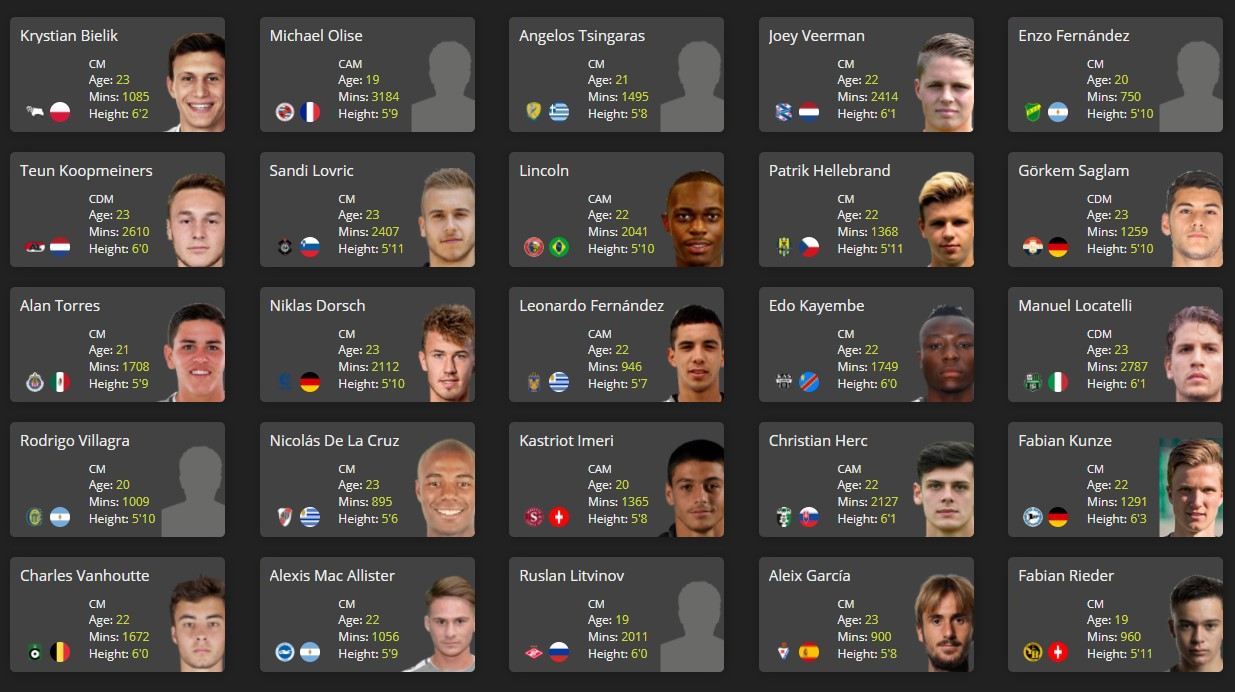
Keen followers of the Eredivisie won’t be surprised to see AZ Alkmaar’s Teun Koopmeiners as one of the best switchers of play. He strikes the ball wonderfully with his left foot and often drops from his position in the double-pivot into the left back space to fire the ball over to the right to Calvin Stengs.
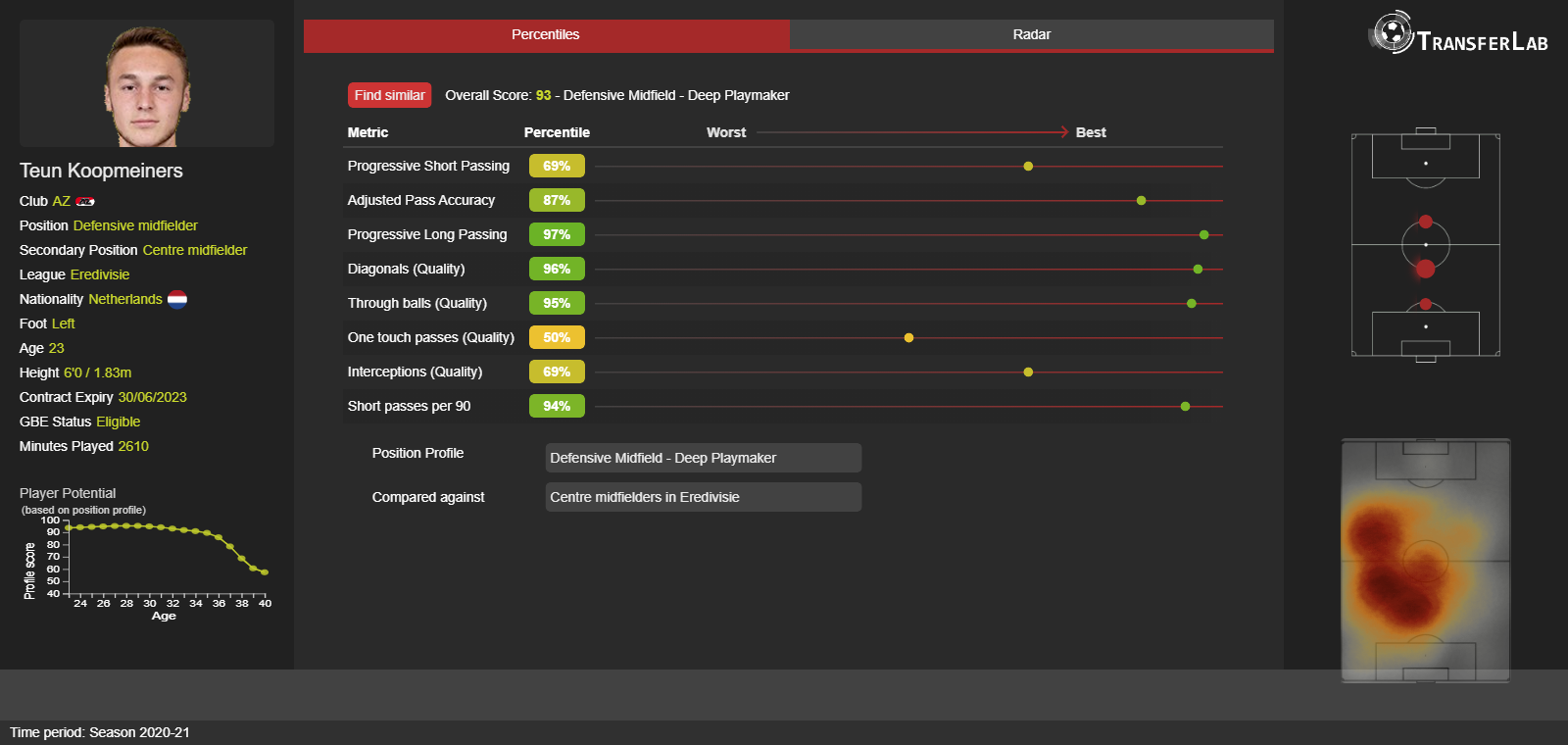
He is another player hotly tipped to move this summer with Serie A sides most heavily linked in recent months. He has also been mentioned by some as a potential option in defensive midfield for Manchester United, specifically because of his ability to progress the ball forwards.
Switching the ball high up the field to the right is a big part of how he does that role for his team. As you can see in his ‘deep playmaker’ profile above, he ranks in the 97th percentile for Eredivisie midfielders for progressive long passing, as well as ‘diagonals’, another metric which will be covered in the coming weeks.
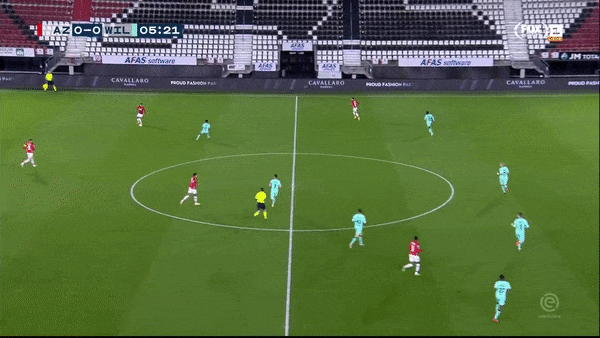
As a further demonstration of the filtering options available on TransferLab, I ran a search of Tier 1 and 2 leagues only, this time looking for a left back who is strong at switching the ball. This search was also filtered to U23s only but I also added in a filter for GBE eligible players only, since this is something which English clubs will have to be very aware of from now on. TransferLab has a tool built in to identify players who will gain work permits. All of these players have played a minimum of 720 minutes in the 20/21 season:

On this list is 18-year-old Nuno Mendes of Sporting Lisbon, who has broken through in a big way this season and is already being linked to a big-money move. The top rumour is currently Manchester United where the road from Sporting has already been walked by his compatriot Bruno Fernandes.
Considering that Luke Shaw is in the form of his life and Alex Telles only joined this season, this seems an unlikely move at this stage but he performs very well according to TransferLab’s algorithms for a player of his age and has great potential to develop into a star.
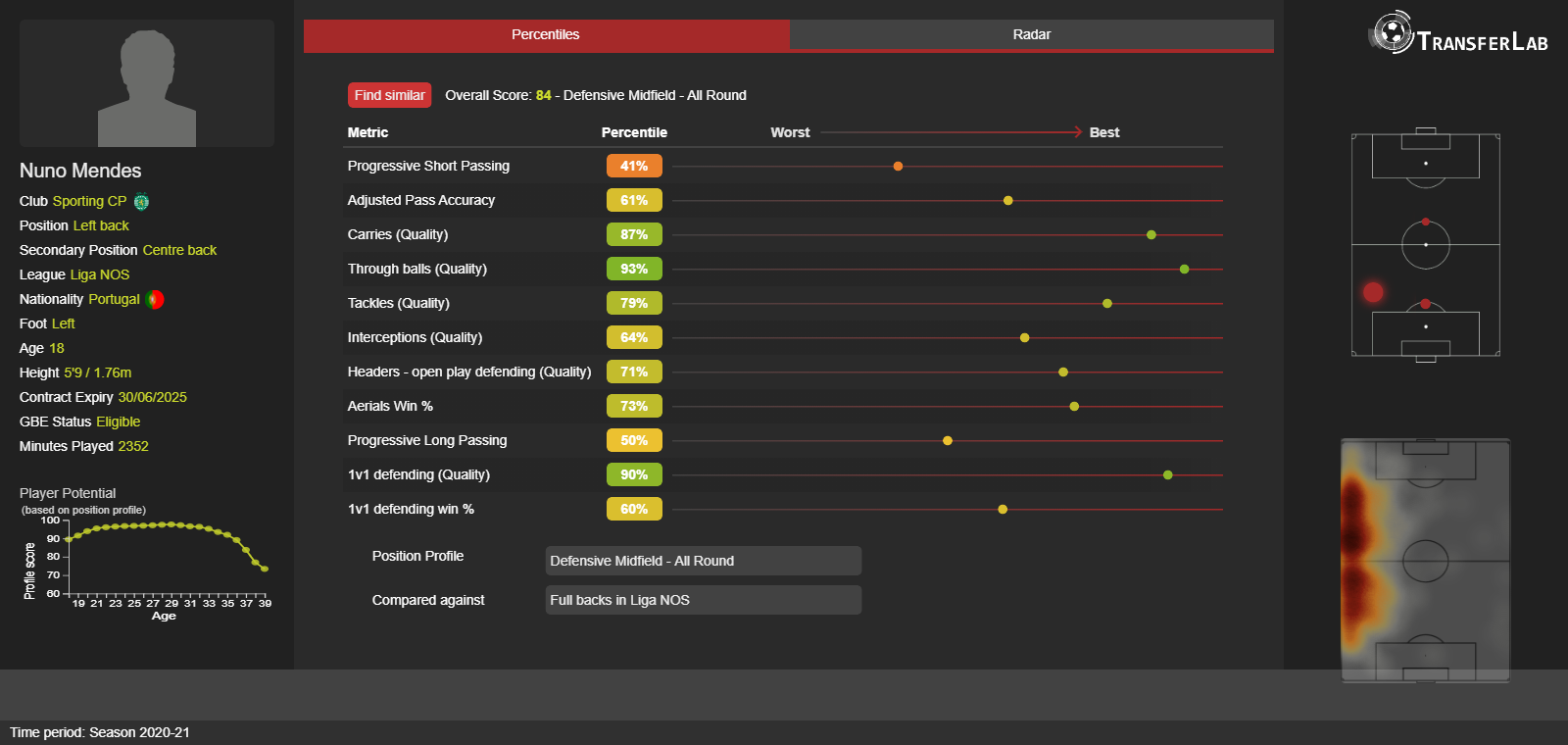
Here is an example of him switching the ball in a game for the Portugal national team:
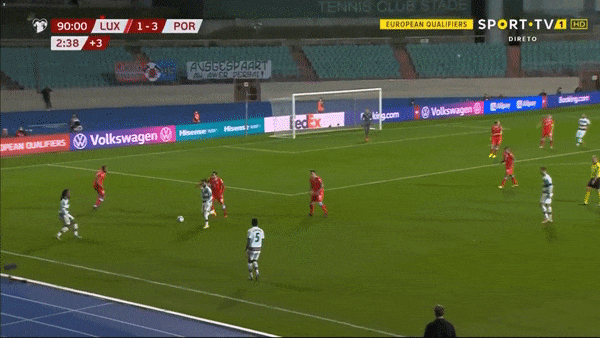
In this case, it was late in the game and Portugal were keeping the ball away from Luxembourg. Switches of play are very effective in keeping possession if executed correctly, as they keep the opponent chasing the ball and having to adjust their shape. Obviously, they are a lot harder to execute in a game situation than a short-range pass but here Mendes backed his ability to make the pass and executed it very well.
There are plenty more filtering options which could be run with this metric, including market value, filtering for specific leagues, minimum age instead of maximum age and even height. Whichever additional filters one might want to add, using the Markov Chain model, we are able to find players who add real value to their team with their cross-field passing rather than having to look through those players who simply play a high number of long-range passes per 90 and manually filtering down from there.
Developing New Metrics
In this series, we will be covering a number of novel metrics we have developed using TransferLab’s algorithm. However, we can create any number of new metrics to determine whether certain in-game actions accrue or reduce goal difference in games.
Using the algorithm, we can assign a “Goal Difference Added” per 90 value to any on-field action that moves the ball from one part of the pitch to another and then compare players using these values.
If you have any ideas about potential metrics, do get in touch with us and we’ll see what we can do to implement them.
Analytics FC provides software and data services to entities within football looking to realise the gains possible from analytical thinking. We provide cutting-edge software solutions such as TransferLab, which helps improve and simplify recruitment decisions. To find out more about TransferLab and our other data services, or to find out more about us, visit our website.
Header image copyright IMAGO / Propaganda Photo










